Serving 1,257 students in grades 6-8, Five Forks Middle School ranks in the top 20% of all schools in Georgia for overall test scores (math proficiency is top 20%, and reading proficiency is top 20%).
The percentage of students achieving proficiency in math is 60% (which is higher than the Georgia state average of 37%). The percentage of students achieving proficiency in reading/language arts is 60% (which is higher than the Georgia state average of 40%).
The student:teacher ratio of 16:1 is higher than the Georgia state level of 14:1.
Minority enrollment is 75% of the student body (majority Black and Hispanic), which is higher than the Georgia state average of 65% (majority Black and Hispanic).
Quick Stats (2025)
- Grades: 6-8
- Enrollment: 1,257 students
- Student:Teacher Ratio: 16:1
- Minority Enrollment: 75%
- Overall Testing Rank: Top 20% in GA
- Math Proficiency: 60% (Top 20%)
- Reading Proficiency: 60% (Top 20%)
- Science Proficiency: 53% (Top 1%)
- Source: National Center for Education Statistics (NCES), GA Dept. of Education
Top Rankings
Five Forks Middle School ranks among the top 20% of public schools in Georgia for:
Category
Attribute
Overall Rank
Math Proficiency
Reading/Language Arts Proficiency
Diversity
School Overview
Five Forks Middle School's student population of 1,257 students has grown by 6% over five school years.
The teacher population of 78 teachers has grown by 16% over five school years.
Grades Offered
Grades 6-8
Total Students
1,257 students
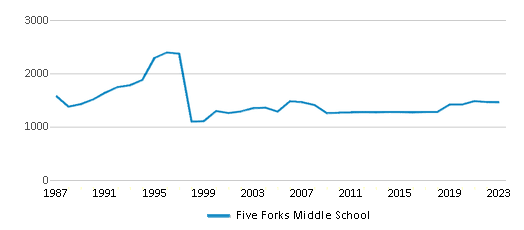
Gender %
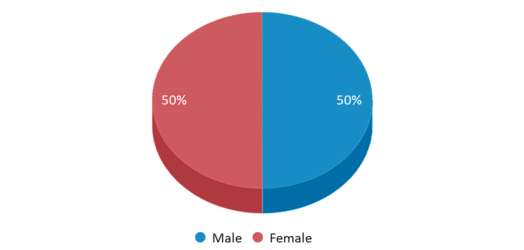
Total Classroom Teachers
78 teachers

Students by Grade
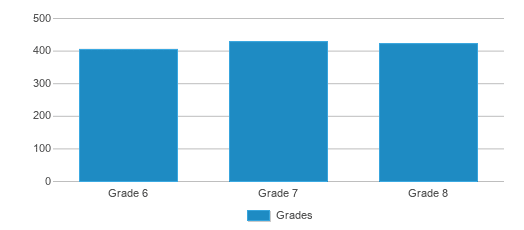
School Calendar
School Rankings
Five Forks Middle School ranks within the top 20% of all 2,204 schools in Georgia (based off of combined math and reading proficiency testing data).
The diversity score of Five Forks Middle School is 0.78, which is more than the diversity score at state average of 0.71. The school's diversity has stayed relatively flat over five school years.
Overall Testing Rank
#257 out of 2204 schools
(Top 20%)
(Top 20%)
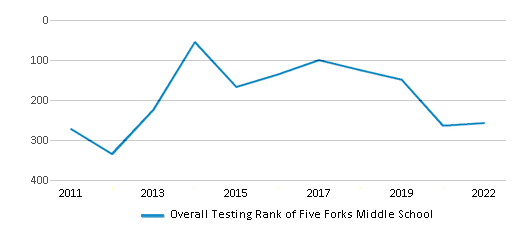
Math Test Scores (% Proficient)
60%
37%
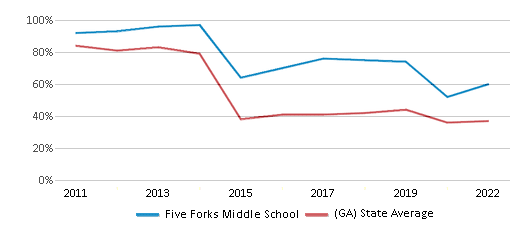
Reading/Language Arts Test Scores (% Proficient)
60%
40%
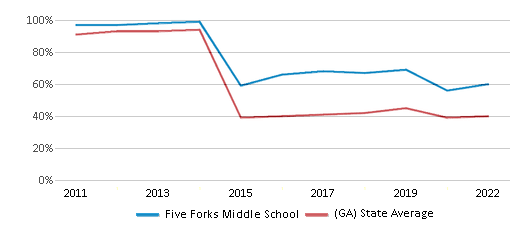
Science Test Scores (% Proficient)
(20-21)53%
38%
Student : Teacher Ratio
16:1
14:1
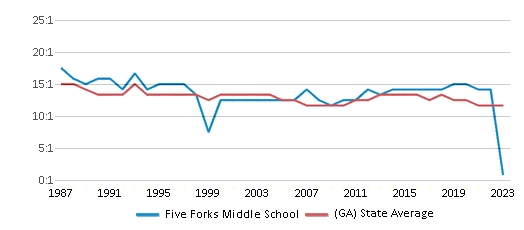
American Indian
n/a
n/a
Asian
19%
5%
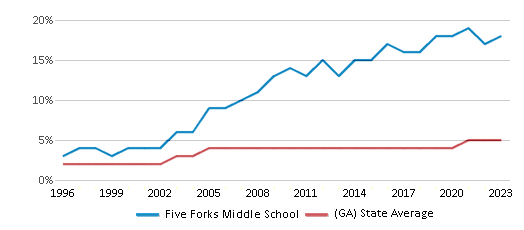
Hispanic
20%
19%
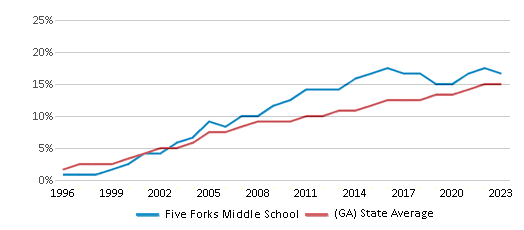
Black
29%
36%
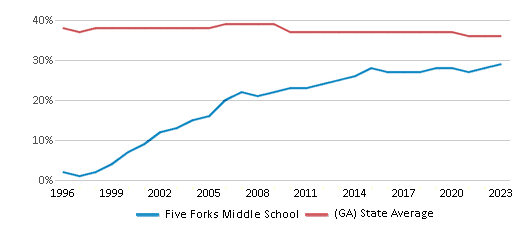
White
25%
35%
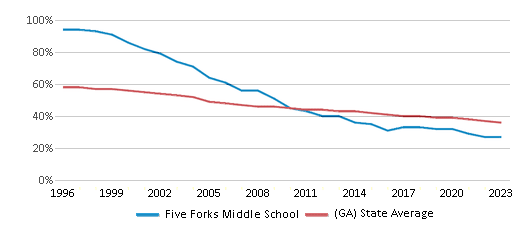
Hawaiian
n/a
n/a
Two or more races
7%
5%
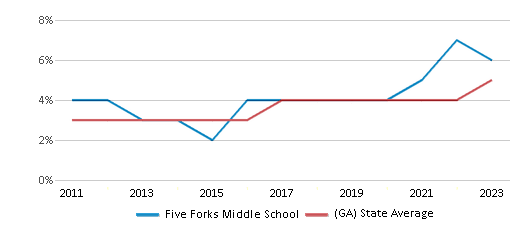
All Ethnic Groups
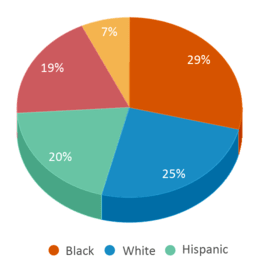
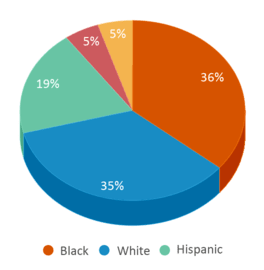
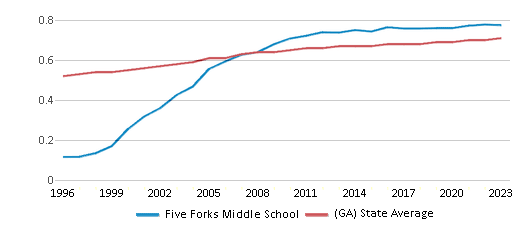
Participates in the National School Lunch Program (NSLP)
Yes
Eligible for Free Lunch
44%
59%

Eligible for Reduced Lunch
7%
5%
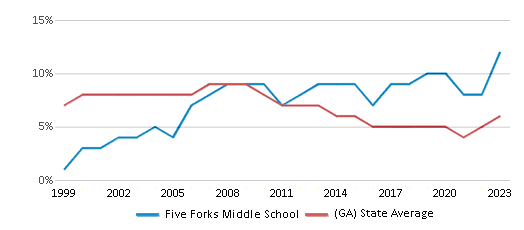
School Statewide Testing
School District Name
Source: National Center for Education Statistics (NCES), GA Dept. of Education
Profile last updated: 02/09/2025
Frequently Asked Questions
What is Five Forks Middle School's ranking?
Five Forks Middle School is ranked #257 out of 2,204 schools, which ranks it among the top 20% of public schools in Georgia.
What schools are Five Forks Middle School often compared to?
Five Forks Middle Schoolis often viewed alongside schools like Crews Middle School by visitors of our site.
What percent of students have achieved state testing proficiency in math and reading?
60% of students have achieved math proficiency (compared to the 37% GA state average), while 60% of students have achieved reading proficiency (compared to the 40% GA state average).
How many students attend Five Forks Middle School?
1,257 students attend Five Forks Middle School.
What is the racial composition of the student body?
29% of Five Forks Middle School students are Black, 25% of students are White, 20% of students are Hispanic, 19% of students are Asian, and 7% of students are Two or more races.
What is the student:teacher ratio of Five Forks Middle School?
Five Forks Middle School has a student ration of 16:1, which is higher than the Georgia state average of 14:1.
What grades does Five Forks Middle School offer ?
Five Forks Middle School offers enrollment in grades 6-8
What school district is Five Forks Middle School part of?
Five Forks Middle School is part of Gwinnett County School District.
School Reviews
5 3/15/2021
Five Forks is just perfect! The staff and teachers here always listen to the students and are very respectful to everybody. My kids are in accelerated classes, all thanks to the hard-working teachers here that make sure our children get the proper education needed to succeed, and they have more than 50 clubs and activities for my child to participate in! In addition, my kids seem to love it here, and I feel the same way. Keep up the good work!
3 6/30/2018
Not all teachers are bad. Some don't care at all. AP's don't return emails or concern. 6th grade is hard no matter what school but don't expect much support from the staff. My son is not the easiest to teach due to his attention deficit issues, he is not perfect but he is WAY smarter and well behaved than they have him pegged. I wish my son was somewhere else!
2 8/9/2010
You should stop the bullying! I was teased and called names RIGHT IN FRONT OF THE TEACHER!! And she didn't even say anything, she just smiled! (it was a sub.)
Review Five Forks Middle School. Reviews should be a few sentences in length. Please include any comments on:
- Quality of academic programs, teachers, and facilities
- Availability of music, art, sports and other extracurricular activities
Recent Articles

What Is A Charter School?
Explore the world of charter schools in this comprehensive guide. Learn about their history, how they operate, and the pros and cons of this educational innovation. Discover key facts about charter schools, including admission policies, demographics, and funding, as well as what to look for when considering a charter school for your child.

10 Reasons Why High School Sports Benefit Students
Discover the 10 compelling reasons why high school sports are beneficial for students. This comprehensive article explores how athletics enhance academic performance, foster personal growth, and develop crucial life skills. From improved fitness and time management to leadership development and community representation, learn why participating in high school sports can be a game-changer for students' overall success and well-being.

February 05, 2025
Understanding the U.S. Department of Education: Structure, Impact, and EvolutionWe explore how the Department of Education shapes American education, from its cabinet-level leadership to its impact on millions of students, written for general audiences seeking clarity on this vital institution.









